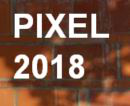Heiko Christian Augustin
(Ruprecht Karls Universitaet Heidelberg (DE))
The Mu3e experiment is searching for the charged lepton flavour violating decay $ \mu^+\rightarrow e^+ e^- e^+ $, aiming for an ultimate sensitivity of one in $10^{16}$ decays. In an environment of up to $10^9$ muon decays per second the detector needs to provide precise vertex, time and momentum information to suppress background. The detector consists of cylindrical layers of $ 50\ \mu\text{m} $ thin High Voltage Monolithic Active Pixel Sensors(HV-MAPS) placed in a $1\ T$ magnetic field, which allow a precise vertex and momentum reconstruction. Additional layers of fast scintillating fibre and tile detectors are providing sub-nanosecond time resolution.
The MuPix8 chip is the first large scale prototype, proving the scalability of the technology. It was produced in the AMS aH18 $180\, \text{nm}$ HV-CMOS process. It consists of three sub-matrices, each providing an untriggered datastream with more than $10\ \text{MHits}/s$. The latest results from laboratory and testbeam characterisiation will be presented, showing an excellent performance with efficiencies $>99.6$% and a time resolution better than $10\ \text{ns}$ achieved with time walk correction. Further, first results from the new prototype MuPix9 will be highlighted and the R&D roadmap towards the final Mu3e chip will be shown.
Heiko Christian Augustin
(Ruprecht Karls Universitaet Heidelberg (DE))
Ivan Peric
(KIT - Karlsruhe Institute of Technology (DE))
Andre Schoening
(Ruprecht Karls Universitaet Heidelberg (DE))
Lennart Huth
(Ruprecht Karls Universitaet Heidelberg (DE))
Sebastian Dittmeier
(Ruprecht-Karls-Universitaet Heidelberg (DE))
Adrian Herkert
(Ruprecht Karls Universitaet Heidelberg (DE))
Jens Kroeger
(Ruprecht Karls Universitaet Heidelberg (DE))
Jan Hammerich
(Universität Heidelberg)
David Immig
(Universität Heidelberg)
Mr
Lars Noethe
(Physikalisches Institut Heidelberg)
Annie Meneses Gonzalez
Mr
Thomas Theodor Rudzki
(Physikalisches Institut Heidelberg)
Carsten Grzesik
(Universität Mainz)
Dr
Alexandr Kozlinskiy
(Kernphysik Institut, JGU Mainz)
Niklaus Emanuel Berger
(JGU Mainz)
Alena Larissa Weber
(Ruprecht Karls Universitaet Heidelberg (DE))
Felix Michael Ehrler
(KIT - Karlsruhe Institute of Technology (DE))
Mridula Prathapan
(KIT - Karlsruhe Institute of Technology (DE))
Dirk Wiedner
(Ruprecht Karls Universitaet Heidelberg (DE))
Frank Meier
(Ruprecht Karls Universitaet Heidelberg (DE))
Mr
Christoph Blattgerste
(Physikalisches Institut Heidelberg)
Mr
Marius Koeppel
(Johannes Gutenberg-Universitaet Mainz)
Dr
Iurii Sorokin
Mr
Frederic Stieler
(Johannes Gutenberg-Universitaet Mainz)
Mr
Alexey Tyukin
Mr
Tobias Wagner
(Johannes Gutenberg-Universitaet Mainz)
Frederik Wauters
(katholieke universiteit leuven)
Mr
Marco Zimmermann
(Johannes Gutenberg-Universitaet Mainz)
Rudolf Schimassek
(KIT - Karlsruhe Institute of Technology (DE))
Ms
Hui Zhang
(Karlruher Institut fuer Techologie(KIT))




